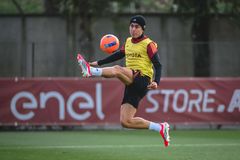


In fact, two of their first three coaches were from the United Kingdom; including Herbert Burgess who built the first Giallorossi outfit to challenge for the Serie A title long before Chris Smalling and Ashley Cole - or even fellow British export John Charles for that matter - wound up on Italian shores.
Born in Manchester on 25 February 1883, this week is the 138th anniversary of Burgess’ birth - a blacksmith who went on to lift the old English First Division, play for his home city’s two biggest clubs, represent England four times and spend two years crafting Roma’s early identity.
As a left-back in his playing days, Burgess became an English champion with Manchester United in 1908, just two years after swapping blue for red after leaving Manchester City.
The defender was also a driver for societal change, helping form the Association Football Players Union (AFPU) in December 1907 in the wake of the tragic death of Burgess’ United teammate Thomas Blackstock in April that year - one brought on by Blackstock heading one of the rock like leather balls of that period.
Burgess went on to play in Denmark and Hungary before being forced into retirement by a persistent knee injury in 1910, and by 1922 he had made in Italy to coach Padova.
He spent four years at the club before another two at AC Milan and then returning to Padova for a second two-year spell, prior to being named Giallorossi coach at the end of 1929.

Roma had only been founded two years previously and spent their first two seasons under the stewardship of Burgess’ compatriot William Garbutt; a man widely remembered as one of Italian football’s most significant forefathers.
Burgess immediately etched his own name into the seminal history of the club, winning the first ever Derby della Capitale in just his second match in charge.
That 1-0 win at Lazio’s Stadio della Rondinella lay down the marker for Roma to follow in the derby ever since and was sealed thanks to Rodolfo Volk’s strike.
Roma also won the second iteration of the derby the following May, this time on home soil at their all-wooden ground Campo Testaccio that was nestled into the heart of the city’s working-class Testaccio neighbourhood.
The scoreline read even more convincingly in Roma’s favour as Burgess led his team to a 3-1 victory, and he would never lose a derby during his time with the Giallorossi as they drew their subsequent two matches the following season.
That second Derby della Capitale glory saw Volk score once again and he was very much one of the key figures in Burgess’ side; one captained by Attilio Ferraris and that also included the likes of Fulvio Bernardini, Arturo Chini Luduena and Guido Masetti.
It was with that team Burgess and Roma pushed eventual champions Juventus all the way in the 1930-31 campaign, finishing just four points behind Juve as runners-up.
Under Burgess, Roma lost just twice at the Olimpico in 38 matches (W31, D5, L2) and, from February to October 1931, they set a record for the club’s longest winning streak (12 matches) that stood for 86 years until the Giallorossi went one better in 2017.
Burgess eventually left Roma at the end of 1931 following a disappointing start to the new term, returning to England before eventually passing away in July 1954 at the grand old age of 71 - just eight years before Charles would wind up at the Stadio Olimpico.
And while Charles’ name will be more universally recognised as a famous footballing Brit in Italy, perhaps only Garbutt from their island can rival Burgess for leaving as indelible a mark on the sport in South Europe.
Rest easy, Herbert. You’ll never be forgotten.
© 2018-2025 Soccer S.r.l. – EU VAT IT09305501000 - all rights reserved. The AS Roma names, logos and artwork are registered or unregistered trademarks of Soccer S.r.l. All other trademarks may be the property of their respective holders.
 Tickets
Tickets
 Shop
Shop





































